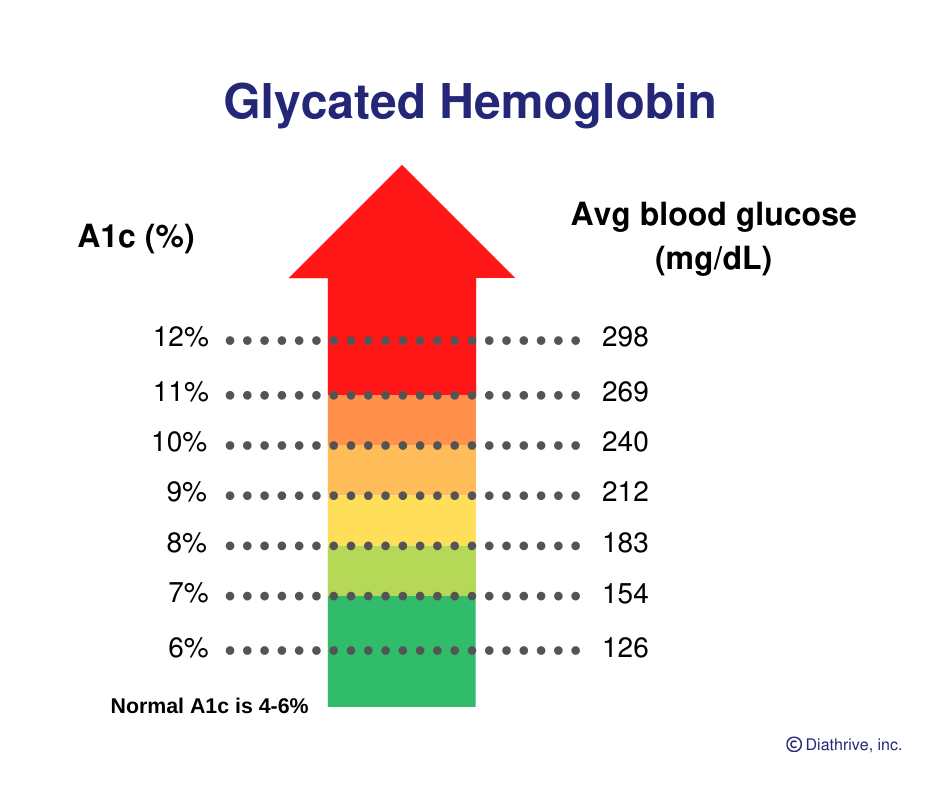
When your doctor tells you your A1c result, do you know what it means? Here's how A1c can be used to help improve diabetes management for both type 1 and type 2 diabetes.
What is A1c?
A1c, also known as hemoglobin test, glycohemoglobin test, hemoglobin A1c test, or HbA1c test, is one of the most important diabetes care data measurements. A1c measures glycated hemoglobin in your system. Hemoglobin is a protein in red blood cells that carries oxygen to your cells. Glucose in your blood attaches to hemoglobin while it is doing its work. If your blood sugar levels run high over time, more glucose will attach and show up in an HbA1c blood test. The American Diabetes Association (ADA) recommends checking your A1c during your doctor visits every 3 to 6 months. But, when your doctor tells you your A1c test result, do you know what it means?
A1c vs. Your Glucose Meter
You can see how your HbA1c result translates to average blood sugar with our A1c chart below. But, your A1c is different from a blood sugar check that you do on your home glucose meter. Your own blood sugar checks give you a current, actionable reading. You can make short-term decisions off of your blood sugar result now based on your own target ranges. For example, if your current blood sugar is 200, you can choose to use some insulin to bring it down, or maybe you can reduce the carbohydrates in your next meal or snack to avoid pushing your blood sugar higher. Checking your blood sugar is key to adjusting day-to-day. Most meters provide average blood sugar levels and estimated average blood glucose levels (EAGs) based on stored data from cumulative readings.
Your A1c level, on the other hand, will tell you how well your blood sugar has been managed over time. It can be viewed as a 30- to 60-day average, and is reported as a percentage. For example, if your A1c is 7.5, that means that 7.5% of your hemoglobin is covered with glucose and your average glucose is about 169 (mg/dL). But, A1c isn't just another number. It's a data point that you can use in your self-care.
Using A1c to improve your diabetes management
The normal A1c range for somebody without diabetes is 4-6%. People who don't have diabetes maintain this range without any additional thought or effort. But those of us who live with diabetes have to work to reach an A1c target of 7% or less, as recommended by the ADA, and reduce the risk of developing additional health issues related to extended high blood sugar. An HbA1c test can be an indicator of whether your current diabetes management plan is working optimally. If the result is higher than your target number, it may be time to discuss other diabetes treatment options with your health care team or adjust your eating strategies to reduce average blood sugar.
Your target A1c goal and current A1c level may be different from other people's because certain other factors should be considered, including diabetes type (type 1, type 2, gestational diabetes, prediabetes, etc.), diabetes complications, additional health conditions like sickle cell disease, liver disease, or kidney disease, therapy needs, procedures such as blood transfusion, and your risk factor for severe hypoglycemia (low blood sugar).
A1c isn't the full story
While your HbA1c level can tell you a great deal about how well your personal diabetes management is going, it cannot tell you everything. If you think about the number as an average for the last 30 days, there is an enormous range that can get you there. If your HbA1c is 5 you may have maintained a steady blood sugar range of 90 to 104 mg/dL over the last 3 months, or you could have been dealing with several high and low blood sugar episodes that average out to 97 mg/dL. Learn more from diaTribe about the nuance of using A1c as the gold standard and how it cannot capture other critical outcomes that matter.
Remember: living with diabetes is a journey. The numbers are simply data points. And, you can find new ways to work with your healthcare provider and adjust your diabetes management plan to achieve better health outcomes.
Want a better understanding of your latest A1c result? Check out our A1c conversion chart.

Originally published July 2018. Updated October 2020.

